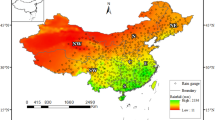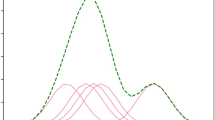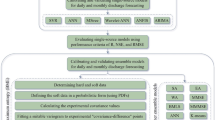Abstract
Seasonal precipitation forecasting is valuable for regional water management and agricultural food security. Current numerical models have large uncertainty in model structure, parameterization and initial conditions. Here, a data-driven multi-model ensemble is constructed using a series of statistical and machine learning methods with varying inputs. Deterministic precipitation forecasts are produced by the weighting of ensemble members using Bayesian model averaging (BMA) and probabilistic forecasts are generated by sampling from BMA predictive probability density function (PDF). Three mathematical metrics are used to evaluate the performance of precipitation forecasts, including Pearson’s correlation coefficient (PCC), root mean square error skill score (RMSESS) and continuous ranked probability skill score (CRPSS). The results demonstrate that the accuracy in the statistical ensemble is significantly higher than the North American multi-model ensemble (NMME) for both deterministic and probabilistic precipitation forecasts, especially at 1-month lead. Statistical models are considerably enhanced by incorporating wavelets, which decomposes the raw precipitation series into several different levels, potentially representing underlying precipitation patterns at different time-frequency scales. Selecting some good ensemble members can improve the ensemble performance, instead of including all the ensemble members with some inefficient models. Overall, the statistical ensemble can be considered as an effective complement of numerical models in both deterministic and probabilistic precipitation forecasts.








Similar content being viewed by others
References
Abbaszadeh P (2016) Improving hydrological process modeling using optimized threshold-based wavelet de-noising technique. Water Resour Manage 30:1701–1721
Anthes RA, Kuo YH, Hsie EY, Low-Nam S, Bettge TW (1989) Estimation of skill and uncertainty in regional numerical models. Q J R Meteorol Soc 115:763–806
Bauer P, Thorpe A, Brunet G (2015) The quiet revolution of numerical weather prediction. Nature 525:47
Becker A, Finger P, Meyer-Christoffer A, Rudolf B, Ziese M (2011) GPCC full data reanalysis Version 6.0 at 1.0: monthly land-surface precipitation from rain-gauges built on GTS-based and historic Data. Global Precipitation Climatology Centre (GPCC): Berlin, Germany
Becker E, den D Hv, Zhang Q (2014) Predictability and forecast skill in NMME. J Clim 27:5891–5906
Berkhahn S, Fuchs L, Neuweiler I (2019) An ensemble neural network model for real-time prediction of urban floods. J Hydrol 575:743–754
Bosilovich MG, Robertson FR, Chen J (2011) Global energy and water budgets in MERRA. J Clim 24:5721–5739
Breiman L (2001) Random forests. Mach Learn 45:5–32
Cannon AJ, Sobie SR, Murdock TQ (2015) Bias correction of GCM precipitation by quantile map**: how well do methods preserve changes in quantiles and extremes? J Clim 28:6938–6959
Chan JC, Zhou W (2005) PDO, ENSO and the early summer monsoon rainfall over south China. Geophys Res Lett 32:1
Choubin B, Khalighi-Sigaroodi S, Malekian A, Kişi Ö (2016) Multiple linear regression, multi-layer perceptron network and adaptive neuro-fuzzy inference system for forecasting precipitation based on large-scale climate signals. Hydrol Sci J 61:1001–1009
Cortes C, Vapnik V (1995) Support-vector networks. Mach Learn 20:273–297
Cuo L, Pagano TC, Wang QJ (2011) A review of quantitative precipitation forecasts and their use in short- to medium-range streamflow forecasting. J Hydrometeorol 12:713–728. https://doi.org/10.1175/2011JHM1347.1
Darji MP, Dabhi VK, Prajapati HB Rainfall forecasting using neural network: A survey. In: 2015 international conference on advances in computer engineering and applications (2015) IEEE, pp 706–713
Daubechies I (1992) Ten lectures on wavelets
Drucker H, Burges CJ, Kaufman L, Smola AJ, Vapnik V Support vector regression machines. In: Advances in neural information processing systems, 1997. pp 155–161
Gers FA, Schmidhuber J, Cummins F (1999) Learning to forget: continual prediction with LSTM
Ham Y-G, Kim J-H, Luo J-J (2019) Deep learning for multi-year ENSO forecasts. Nature 573:568–572
Hao Z, Singh VP, **a Y (2018) Seasonal drought prediction: advances, challenges, and future prospects. Rev Geophys 56:108–141
Harris I, Jones PD, Osborn TJ, Lister DH (2014) Updated high-resolution grids of monthly climatic observations—the CRU TS3.10 Dataset. Int J Climatol 34:623–642. https://doi.org/10.1002/joc.3711
Haykin S (1994) Neural networks: a comprehensive foundation. Prentice Hall PTR, NJ
Heil CE, Walnut DF (1989) Continuous and discrete wavelet transforms. SIAM Rev 31:628–666
Hersbach H (2000) Decomposition of the continuous ranked probability score for ensemble prediction systems. Weather Forecast 15:559–570
Hochreiter S, Schmidhuber J (1997) Long short-term memory. Neural Comput 9:1735–1780
Hoeting JA, Madigan D, Raftery AE, Volinsky CT (1999) Bayesian model averaging: a tutorial. Stat Sci 1:382–401
Ingram K, Roncoli M, Kirshen P (2002) Opportunities and constraints for farmers of West Africa to use seasonal precipitation forecasts with Burkina Faso as a case study. Agric Syst 74:331–349
Jolliffe IT, Stephenson DB (2012) Forecast verification: a practitioner’s guide in atmospheric science. Wiley, UK
Kai S, Mueller SC, Ross J (1983) Periodic precipitation patterns in the presence of concentration gradients. 2. Spatial bifurcation of precipitation bands and stochastic pattern formation. J Phys Chem 87:806–813
Khajehei S, Ahmadalipour A, Moradkhani H (2018) An effective post-processing of the North American multi-model ensemble (NMME) precipitation forecasts over the continental US. Clim Dyn 51:457–472
Khajehei S, Moradkhani H (2017) Towards an improved ensemble precipitation forecast: a probabilistic post-processing approach. J Hydrol 546:476–489
Kim T-W, Valdés JB (2003) Nonlinear model for drought forecasting based on a conjunction of wavelet transforms and neural networks. J Hydrol Eng 8:319–328
Kirtman BP et al (2014) The North American multimodel ensemble: phase-1 seasonal-to-interannual prediction; phase-2 toward develo** intraseasonal prediction. B Am Meteorol Soc 95:585–601
Knutti R, Sedláček J (2013) Robustness and uncertainties in the new CMIP5 climate model projections. Nat Clim Chang 3:369
Kripalani RH, Kulkarni A (2001) Monsoon rainfall variations and teleconnections over South and East Asia. Int J Climatol 21:603–616
Krishnamurti T, Kumar V, Simon A, Bhardwaj A, Ghosh T, Ross R (2016) A review of multimodel superensemble forecasting for weather, seasonal climate, and hurricanes. Rev Geophys 54:336–377
Li Y, Liang Z, Hu Y, Li B, Xu B, Wang D (2019) A multi-model integration method for monthly streamflow prediction: modified stacking ensemble strategy. J Hydroinf
Lieting C (2001) The Role of the Anomalous Snow Cover over the Qinghai-**zang Plateau and ENSO in the Great Floods of 1998 in the Changjiang River Valley. Chin J Atmos Sci 2
Lipper L et al (2014) Climate-smart agriculture for food security. Nat Clim Chang 4:1068
Maldonado T, Alfaro E, Fallas-López B, Alvarado L (2013) Seasonal prediction of extreme precipitation events and frequency of rainy days over Costa Rica, Central America, using Canonical Correlation Analysis. Adv Geosci 33:41–52
Mallat SG (1989) A theory for multiresolution signal decomposition: the wavelet representation. IEEE Trans Pattern Anal Mach Intell 1:674–693
McFarlane NA, Boer G, Blanchet J, Lazare M (1992) The Canadian Climate Centre second-generation general circulation model and its equilibrium climate. J Clim 5:1013–1044
Molteni F, Buizza R, Palmer TN, Petroliagis T (1996) The ECMWF ensemble prediction system: methodology and validation. Q J R Meteorol Soc 122:73–119
Moon TK (1996) The expectation–maximization algorithm. IEEE Signal Process Mag 13:47–60
Mortensen E et al (2018) Regression-based season-ahead drought prediction for southern Peru conditioned on large-scale climate variables. Hydrol Earth Syst Sc 22:287
Najafi MR, Moradkhani H, Piechota TC (2012) Ensemble streamflow prediction: climate signal weighting methods vs. climate forecast system reanalysis. J Hydrol 442:105–116
Nearing GS, Gupta HV (2018) Ensembles vs. information theory: supporting science under uncertainty. Front Earth Sci 1:1–8
Nourani V, Baghanam AH, Gokcekus H (2018) Data-driven ensemble model to statistically downscale rainfall using nonlinear predictor screening approach. J Hydrol 565:538–551
Partal T, Kişi Ö (2007) Wavelet and neuro-fuzzy conjunction model for precipitation forecasting. J Hydrol 342:199–212
Pokhrel S et al (2016) Seasonal prediction of Indian summer monsoon rainfall in NCEP CFSv2: forecast and predictability error. Clim Dyn 46:2305–2326
Quilty J, Adamowski J, Boucher MA (2019) A stochastic data-driven ensemble forecasting framework for water resources: a case study using ensemble members derived from a database of deterministic wavelet‐based models. Water Resour Res 55:175–202
Raftery AE, Gneiting T, Balabdaoui F, Polakowski M (2005) Using Bayesian model averaging to calibrate forecast ensembles. Mon Weather Rev 133:1155–1174
Ramana RV, Krishna B, Kumar S, Pandey N (2013) Monthly rainfall prediction using wavelet neural network analysis. Water Resour Manage 27:3697–3711
Reichstein M, Camps-Valls G, Stevens B, Jung M, Denzler J, Carvalhais N (2019) Deep learning and process understanding for data-driven Earth system science. Nature 566:195
Roeckner E et al (2003) The atmospheric general circulation model ECHAM 5. Model description, PART I
Rumelhart DE, Hinton GE, Williams RJ (1988) Learning representations by back-propagating errors. Cognit Model 5:1
Saha S et al (2014) The NCEP climate forecast system version 2. J Clim 27:2185–2208
Shi X, Chen Z, Wang H, Yeung D-Y, Wong W-K, Woo W-C, Convolutional LSTM network (2015): A machine learning approach for precipitation nowcasting. In: Advances in neural information processing systems, pp 802–810
Slater LJ, Villarini G, Bradley AA (2017) Weighting of NMME temperature and precipitation forecasts across Europe. J Hydrol 552:646–659
Sloughter JML, Raftery AE, Gneiting T, Fraley C (2007) Probabilistic quantitative precipitation forecasting using Bayesian model averaging. Mon Weather Rev 135:3209–3220
Smola AJ, Schölkopf B (2004) A tutorial on support vector regression. Stat Comput 14:199–222. doi:https://doi.org/10.1023/b:stco.0000035301.49549.88
Stensrud DJ (2009) Parameterization schemes: keys to understanding numerical weather prediction models. Cambridge University Press, Cambridge
Taylor KE, Stouffer RJ, Meehl GA (2012) An overview of CMIP5 and the experiment design. B Am Meteorol Soc 93:485–498
Tebaldi C, Knutti R (2007) The use of the multi-model ensemble in probabilistic climate projections. Philos Trans R Soc A Math Phys Eng Sci 365:2053–2075
Thober S, Kumar R, Sheffield J, Mai J, Schäfer D, Samaniego L (2015) Seasonal soil moisture drought prediction over Europe using the North American Multi-Model Ensemble (NMME). J Hydrometeorol 16:2329–2344
Tong S, Koller D (2001) Support vector machine active learning with applications to text classification. J Mach Learn Res 2:45–66
Trenberth KE, Smith L, Qian T, Dai A, Fasullo J (2007) Estimates of the global water budget and its annual cycle using observational and model data. J Hydrometeorol 8:758–769
Vapnik V (2013) The nature of statistical learning theory. Springer, Berlin
Wang L (2005) Support vector machines: theory and applications. Springer, Berlin
Warszawski L, Frieler K, Huber V, Piontek F, Serdeczny O, Schewe J (2014) The inter-sectoral impact model intercomparison project (ISI–MIP): project framework. Proc Natl Acad Sci 111:3228–3232
**ao M, Zhang Q, Singh VP (2015) Influences of ENSO, NAO, IOD and PDO on seasonal precipitation regimes in the Yangtze River basin, China. Int J Climatol 35:3556–3567
Xu L, Chen N, Zhang X (2018a) A comparison of large-scale climate signals and the North American Multi-Model Ensemble (NMME) for drought prediction in China. J Hydrol 557:378–390. doi:https://doi.org/10.1016/j.jhydrol.2017.12.044
Xu L, Chen N, Zhang X, Chen Z (2018) An evaluation of statistical, NMME and hybrid models for drought prediction in China. J Hydrol 566:235–249. https://doi.org/10.1016/j.jhydrol.2018.09.020
Xu L, Chen N, Zhang X, Chen Z, Hu C, Wang C (2019) Improving the North American multi-model ensemble (NMME) precipitation forecasts at local areas using wavelet and machine learning. Clim Dyn 1:1–15
Yang J, Gong D, Wang W, Hu M, Mao R (2012) Extreme drought event of 2009/2010 over southwestern China. Meteorol Atmos Phys 115:173–184
Zaherpour J et al (2019) Exploring the value of machine learning for weighted multi-model combination of an ensemble of global hydrological models. Environ Model Softw 114:112–128. https://doi.org/10.1016/j.envsoft.2019.01.003
Zong Y, Chen X (2000) The 1998 flood on the Yangtze, China. Nat Hazards 22:165–184
Acknowledgements
This work was supported by grants from the National Key Research and Development Projects (2018YFB2100500), National Natural Science Foundation of China program (no. 41890822), the National Nature Science Foundation of China program (41801339, 41971351, 41771422, 41601406) and the Nature Science Foundation of Hubei Province (2017CFB616).
Author information
Authors and Affiliations
Corresponding author
Additional information
Publisher's Note
Springer Nature remains neutral with regard to jurisdictional claims in published maps and institutional affiliations.
Electronic supplementary material
Below is the link to the electronic supplementary material.
Rights and permissions
About this article
Cite this article
Xu, L., Chen, N., Zhang, X. et al. A data-driven multi-model ensemble for deterministic and probabilistic precipitation forecasting at seasonal scale. Clim Dyn 54, 3355–3374 (2020). https://doi.org/10.1007/s00382-020-05173-x
Received:
Accepted:
Published:
Issue Date:
DOI: https://doi.org/10.1007/s00382-020-05173-x




